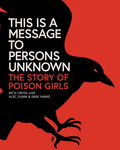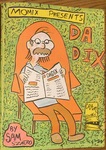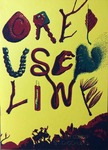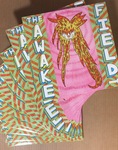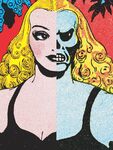
A veteran of street life and all that goes with it, Guy Colwell fills the pages of Inner City Romance with tales of sex and drugs that are far from what most of those who encounter them for the first time here in this volume will have experienced. Originally appearing in the 1970s, the stories deal with LSD, heroin and hedonism, yes, but they are situated in a specific environment and the comics work to connect these behaviors to the poverty and neglect that the characters that populated them have experienced in their lives. It is also important to note that the "inner cIty" of the title can be read to mean, or at least imply, "inter-racial." Colwell's work is fairly unique, even today, for its bold portrayal of intimate relations people of African and European descent. These comics work to bring the "far out", late-60s, taboo-busting work of Crumb (Angelfood McSpade, Whiteman, etc) and others down to earth. They work to engage the realist æsthetic and provide a degree of verisimiltude that was previously lacking (although these comics too are not free from prurient interest). It is important to keep in mind when confronting the characters, situations and narratives contained in this volume that there is no avoiding the fact that as a white male artist, Colwell is carrying his own baggage of assumptions that he inevitably unpacks in this work that portrays a wide variety of relations between black and white characters of both genders. Furthermore, his ability to have these comics published at that time is inextricably related to his social position as a white man. Thus, due to the historical forces in operation, comics readers, even today, are only seeing the white point of view of these inter-racial scenarios. That said, the comics that make up Inner City Romance indicate that they are not simply products of idle fantasy but are rooted in some real life experiences, and while Colwell's comics lack the power to unlock the unconscious possessed by those created by Crumb, they are also far less caricatured, and so provide their readers with a unique window on this layer of history that presently lies beneath the surface of our current social fabric.

Published by Fanta's FU Press imprint. Here's what they have to say about it:
"Guy Colwell, the seminal underground cartoonist who created Inner City Romance, has been constructing social realist pen and ink drawings for nearly half a century. Street Scenes collects his most moving drawings focusing on both the vile decay and inspirational vibrancy of city life in a series of 36 stand-alone plates."
Please note: Street Scenes has been produced in a signed and numbered edition of only 200 hand bound copies.

Just In: "Guy Colwell's first full graphic novel in 33 years." That's cause enough for celebration!
Here, in the 160 black & white pages of this deluxe, embossed hardcover edition Guy Colwell imagines the life and work – secifically the singular work or which he is most widely known, "The Garden of Earthly Delights".
Here's the Fanta blurb:
An obsessive painter, working away for years in near secrecy, now reveals a magnum opus to the world — author and subject, intertwined.
In Guy Colwell's first full graphic novel in 33 years, we see one painter, Colwell himself, consider another, Hieronymus Bosch, and the story behind the latter's most notable work told in sequential panels. The known details of Bosch's life, and the commissioning of his enormous triptych "The Garden Of Earthly Delights," are scant. Colwell takes the facts of Bosch's time and setting and constructs a tale of a man and artist torn equally among piety, creativity, and commerce.
In Colwell's version of Jheronimus van Aken (Bosch's real name), he is an artist paid well by local dukes to paint a vision of the world before the fall, but will the religious leaders of his village see it as celebrating God's creation, or fatally corrupted by sensuality? And what of the increasing numbers of young models needed to depict pre-apple innocence?
This imaginatively conceived historical graphic novel is Colwell's crowning achievement in a cartooning career, begun in the underground comix movement of the 1970s, and marked by risk-taking and political engagement. His drawing, rendering, and storytelling has never been as self-assured as in Delights.
Praise
"Painter and underground cartoonist Colwell turns the commissioning of The Garden of Earthly Delights in late 15th-century Netherlands into an epochal struggle between faith and doubt, superstition and reason. ... a thought-provoking venture into a time when art had life-or-death consequences." — Publishers Weekly




